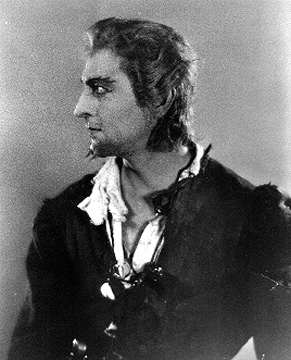FILM NOTES
FILM NOTES INDEX
NYS WRITERS INSTITUTE
HOME PAGE

 The Beloved Rogue
The Beloved Rogue
(American, 1927, 110 minutes, b&w, silent, 16mm)
Directed by Alan Crosland
Cast:
Francois Villon……….John Barrymore
King Louis XI……….Conrad Veidt
Charlotte de Vauxcelles……….Marceline Day
Duke of Burgundy……….Lawson Butt
The following film notes were prepared for the New York State Writers Institute by Kevin Jack Hagopian, Senior Lecturer in Media Studies at Pennsylvania State University:
He was a man you have never heard of, and yet his stamp is on the American cinema, indelible, as in THE GODFATHER, PART II (1974), and in the unified design of films like Terence Malick's DAYS OF HEAVEN (1978), Terry Gilliam's BRAZIL (1985), and David Lynch's BLUE VELVET (1986). He was William Cameron Menzies, and included in the impressive title he invented, "production designer," was a sense of total command of the image. Deeply connected to the art historical trends of his times, Menzies' aesthetic underwent complete revision over the long course of his career, which spanned nearly 50 years of film history. Art nouveau, German expressionism, Art Deco, American regionalism; Menzies brought them all to films as diverse as SADIE THOMPSON (1928), GONE WITH THE WIND (1939), and OUR TOWN (1940). In the late silent era, Menzies was part of a cinematic generation of masters. Joseph Urban at Cosmopolitan Studios, Anton Grot at Warner Brothers and other studios, and Cedric Gibbons at MGM, all shaped film decor. But it was Menzies who truly instituted the profession, creating artistic unity in an industry which loved compartmentalization. He wrote and spoke publicly about the need to gather responsibility for the entire visual sphere in the hands of one artist. A born illustrator, Menzies brought the art of storyboarding to Hollywood, and integrated design with cinematography and editing in a way that revolutionized visual design in the cinema. Not surprisingly, he won the first Academy Award for art direction.
Menzies' contribution to BELOVED ROGUE was typical of the work he had been doing since he was brought to Hollywood at the behest of Douglas Fairbanks. Like the 1924 Menzies-Fairbanks masterpiece, THE THIEF OF BAGHDAD, and like the other films Menzies designed for Fairbanks (THE THREE MUSKETEERS [1921] and ROBIN HOOD [1922]), and for Rudolph Valentino (THE EAGLE [1925] and THE SON OF THE SHEIK [1926]), THE BELOVED ROGUE was sheer fantasy. Menzies' set designs - the timbered garrets, the sumptuous court interiors of Louis XI, and the mysterious, erotic chambers of the lovely Charlotte - all these brought an air of spectacular romance to THE BELOVED ROGUE. The film's stars, John Barrymore as Villon, and Conrad Veidt as Louis, are dwarfed by the bold lines and huge scale of Menzies' sets; occasionally, the actors looked as though they were placed there by Menzies, mere decorations for the fabulous tableaus which are the real stars of the film. With crack cinematographer Joe August, Menzies made this slight entertainment a dramatic epic, the visual sweep of the film expressing Villon's own passion in looming, lyrical, articulate silence.
Menzies had been designing sets, and then entire productions, since 1919's THE TEETH OF THE TIGER. Eventually, he would direct films, as well. At the time of THE BELOVED ROGUE, he was deeply involved in an aesthetic of sheer fantasy, a delightful landscape of the imagination presented through witty borrowings from various European styles, creating a new visual lexicon every time the camera rolled.
Within a few months, sound would change the artistic world. Menzies would shift to an even more dramatic, deeply expressionistic mode for BULLDOG DRUMMOND (1930). Just as deftly, he mastered streamlined Moderne for the H.G. Wells science fiction drama THINGS TO COME (1936), and then the American Regionalism of Thomas Hart Benton, John Steuart Currry, and Grant Wood for films such as GONE WITH THE WIND, OUR TOWN, and his late masterpiece, KING'S ROW (1941). By then, the idea of a single, strong hand at the visual throttle of a film was a fact of life in the American film industry, and for the great designers of the postwar era, Boris Leven, Richard Sylbert, Ken Adam, and Dean Tavoularis, Menzies was a father figure. Sylbert, who designed LONG DAY'S JOURNEY INTO NIGHT (1962), THE MANCHURIAN CANDIDATE (1962), CHINATOWN (1974), REDS (1981), and THE COTTON CLUB (1984), got his first design credit on a film Menzies was directing. Initially terrified, Sylbert got a unique education, as each evening Menzies patiently sketched out the next day's shots for Sylbert on hotel stationery.
In an essay for Theatre Arts in 1939, Menzies explained that he was concerned with "form, composition by point of view, and arrangement of properties, figures, and architectural masses." Seventy years later, Richard Sylbert put it very simply: "What he did was to structure a film's visual content."
— Kevin Hagopian, Penn State University
For additional information, contact the Writers Institute at 518-442-5620 or online at https://www.albany.edu/writers-inst.